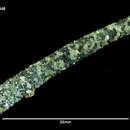en
names in breadcrumbs


“Pectinaria ehlersi, Hessle.
Pectinaria belgica, Ehlers, nec Pallas, 1901, p. 204.
Pectinaria ehlersi, Hessle, 1917, p. 77, pl. i, fig. i, text fig. 3 a-e.
Pectinaria (Cistenides) ehlersi, Nilsson, 1928, p. 33, fig. 10 a, b.
Occurrence. St. WS 212 (i); WS 236 (i).
Specific characters. Tentacular membrane with 20-30 processes. Up to about 15 paleae on each side. Seventeen chaetigers, of which 13 (from the 4th to the 16th) are uncinigerous. Dorsal bristles of two kinds — straight, narrowly bordered bristles with delicately hirsute ends; and bristles with curved tips strongly denticulated on the concave side. In profile the uncini have four large teeth above the finely denticulated basal region. This is the most easily appreciable difference between ehlersi and belgica which has hooks with seven to eight teeth in profile instead of four.
Remarks. The present material consists of one ill-preserved complete specimen (St. WS 236) measuring 21 mm. by 3 mm. at the widest part, and one anterior fragment of about eight chaetigers.
Nilsson attributes this species to the subgenus Cistenides which he separates from Pectinaria, sensu Malmgren, almost entirely on the presence in the former of a granular area on the dorsal surface of the segment preceding the scapha. I am not convinced that any good purpose is served by retaining these subgenera. The rather ill-preserved scapha in the present specimen corresponds to Hessle's figure except that I cannot see the two lateral papillae at the sides of the anal ligule, and the hinder border of the latter appears to be faintly crenate and not smooth, as Hessle figures it. The tube is composed of small brown sand-grains and is very slightly curved.”
(Monro, 1936)